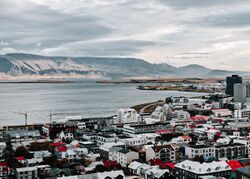Mianuuva: Difference between revisions
(Created page with "{{Infobox settlement | name = Mianuuva | other_name = | official_name = Mianuuva | native_name_lang = ᒥᐊᓅᕙ |s...") |
No edit summary |
||
| Line 77: | Line 77: | ||
== Education == | == Education == | ||
{{Template:INWU}} | |||
Revision as of 21:42, 31 March 2020
Mianuuva | |
|---|---|
Capital City | |
| Mianuuva | |
 Skyline of downtown Mianuuva overlooking Iikiug Bay and Mt. Mianuuva. | |
| Motto(s): "ᒦᓰᓪ ᐊᐊ ᓲᒃᒃ ᐊᒃᒃᒥᒨᓛᐃᐊᔅ" "Where the ice falls." | |
| Mianuuva founded | c. 444 AC |
| Government | |
| • Mayor | Liiaak Simm |
| Area | |
| • Capital City | 245.54 km2 (94.80 sq mi) |
| • Land | 227.7 km2 (87.9 sq mi) |
| • Water | 17.84 km2 (6.89 sq mi) |
| Highest elevation | 245.1 m (804.1 ft) |
| Lowest elevation | −0.8 m (−2.6 ft) |
| Population (2019) | |
| • Density | 502.44/km2 (1,301.3/sq mi) |
| • Metro | 123,371 |
| Demonym | Mianuuvan |
| Time zone | UTC-11:00 (TBD) |
| ZIP Code | 4419 |
| Kilalurian Area Code | 011-020 |
| Website | www.mianuuvacity.kila.gov |
Mianuuva (Kilalurian: ᒥᐊᓅᕙ) is the capital and largest city of Kilalurak. It is located on the northern coast of Kilalurak on the Iikiug Bay. Mianuuva is at 71° 23' 6.5112 N, making it the word's most northern capital city. Mianuuva, having a population of 123,000, is the cultural, economic, governmental, and artistic center of Kilalurak. It is also famous for its tourist attractions, including but not limited to whale watching, Kilalurian art, and famous cuisine.
Mianuuva is believed to be the second capital city of Kilalurak, its first being abandoned during war times in 1523. According to the Muuk, Mianuuva was founded by Nanuuk Nimaluuk Livvii in the year 444 AC. Its old capital, Viksaluk, was located on the southern coast of North Kilalurak. The city was established as a trading outpost in 1625, mainly exporting furs and skins of local animals. In the year 1641, Mianuuva was established as a place of commerce and grew to one of the largest cities within only 35 years. Mianuuva prides itself in its conservation program of the nearby Taaliluk Forest and its recycling program. It is, to this day, one of the greenest and safest capital cities in the world, having only 16 violent crimes since 2009.

